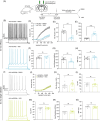Inhibition of the GSK3β/Nav1.6 complex suppresses early-stage Alzheimer's hyperexcitability
- PMID: 40717647
- PMCID: PMC12301699
- DOI: 10.1002/alz.70507
Inhibition of the GSK3β/Nav1.6 complex suppresses early-stage Alzheimer's hyperexcitability
Abstract
Introduction: Network hyperexcitability (NH) is observed in patients with early-stage Alzheimer's disease (AD), emerging decades before cognitive decline. A key molecular determinant of NH is voltage-gated Na+ channel 1.6 (Nav1.6), which mediates action potential firing in CA1 hippocampal neurons. Ameliorating NH through inhibition of the glycogen-synthase kinase 3β (GSK3β/Nav1.6 complex may provide immediate benefits to cognition and memory and slow AD progression.
Methods: Hight-throughput virtual screening and multiple in vitro biological assays were utilized to identify compound 1063. Patch-clamp electrophysiology and electroencephalogram recordings were utilized to functionally assess 1063 in models of AD neuropathology.
Results: Building on previous studies identifying GSK3β as a modulatory protein binding to the Nav1.6 C-terminal domain (CTD), we identified 1063, a brain-penetrant small molecule that inhibits GSK3β/Nav1.6 complex assembly and reduces NH in AD rodent models.
Discussion: These results demonstrate the potential of the GSK3β/Nav1.6 complex as a therapeutic target for NH in early-stage AD.
Highlights: The glycogen synthase kinase 3-β (GSK3β)/Nav1.6 complex is a potential target for hyperexcitability in early Alzheimer's disease (AD). Compound 1063 dose-dependently decreases GSK3β/Nav1.6 complex assembly. Compound 1063 is functionally specific for Nav1.6 over other central nervous system (CNS) Nav isoforms. Ex vivo functional studies provide evidence for target engagement. 1063 dose-dependently reduces epileptiform activity in AD rodent model.
Keywords: Alzheimer's disease; amyloid beta‐induced hyperexcitability; glycogen synthase kinase 3β; nav1.6; network hyperactivity; neuronal hyperexcitability; small molecule drug discovery; voltage‐gated sodium channel.
© 2025 The Author(s). Alzheimer's & Dementia published by Wiley Periodicals LLC on behalf of Alzheimer's Association.
Conflict of interest statement
The corresponding author, F.L., is the founder and president of IonTx Inc. (Friendswood, TX, USA), a start‐up company focusing on developing regulators of voltage‐gated Na+ channels, and T.J.B is a consulant and M.L. is an employee. The remaining authors do not have any potential conflicts of interest to report. Author disclosures are available in the supporting information.
Figures






Similar articles
-
Triple-Target Inhibition of Cholinesterase, Amyloid Aggregation, and GSK3β to Ameliorate Cognitive Deficits and Neuropathology in the Triple-Transgenic Mouse Model of Alzheimer's Disease.Neurosci Bull. 2025 May;41(5):821-836. doi: 10.1007/s12264-025-01354-y. Epub 2025 Feb 5. Neurosci Bull. 2025. PMID: 39907971
-
Tenascin-R aggravates Aβ production in the perforant pathway by regulating Nav1.6 activity in APP/PS1 mice.Alzheimers Dement. 2025 Sep;21(9):e70633. doi: 10.1002/alz.70633. Alzheimers Dement. 2025. PMID: 40891036 Free PMC article.
-
Increased NaV1.2 expression and its interaction with CaM contribute to the hyperexcitability induced by prolonged inhibition of CaMKII.Epilepsia. 2025 Jul;66(7):2521-2537. doi: 10.1111/epi.18377. Epub 2025 Mar 22. Epilepsia. 2025. PMID: 40119845
-
Natural compounds from herbs and nutraceuticals as glycogen synthase kinase-3β inhibitors in Alzheimer's disease treatment.CNS Neurosci Ther. 2024 Aug;30(8):e14885. doi: 10.1111/cns.14885. CNS Neurosci Ther. 2024. PMID: 39129397 Free PMC article. Review.
-
Decoding the Role of Neurotrophins in Glycogen Synthase Kinase 3-Beta Regulation in Alzheimer's Disease.Mol Neurobiol. 2025 Jul;62(7):8603-8623. doi: 10.1007/s12035-025-04776-x. Epub 2025 Feb 27. Mol Neurobiol. 2025. PMID: 40014269 Review.
References
MeSH terms
Substances
Grants and funding
- R01AG065290/NH/NIH HHS/United States
- R01AG070255/NH/NIH HHS/United States
- R01MH12351/NH/NIH HHS/United States
- R01MH132226/NH/NIH HHS/United States
- T32AG067952-01/National Institute of Aging
- BHI2024-13/Moody Brain Health Institute at the University of Texas
- P87462/Moody Brain Health Institute Pilot Project
- American Epilepsy Society
- P30ES030285/GCC Center for Precision Environmental Health
- P30 CA125123/CA/NCI NIH HHS/United States
- DK056338/Dan Duncan Digestive Disease Center
- P30ES030285/ES/NIEHS NIH HHS/United States
- RP170719/Cancer Prevention and Research Institute of Texas
- T32GM008280/Houston Area Molecular Biophysics Program
LinkOut - more resources
Full Text Sources
Medical
Miscellaneous

